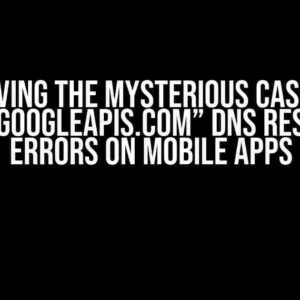Are you pulling your hair out because PIxiedust 1.1.19 is not working despite installing and importing it correctly? You’re not alone! Many developers have faced this frustrating issue, and today, we’re going to help you troubleshoot and resolve it once and for all. So, take a deep breath, relax, and let’s dive into the world of PIxiedust 1.1.19!
- Before We Begin: A Quick Recap of PIxiedust 1.1.19
- Troubleshooting PIxiedust 1.1.19: A Step-by-Step Guide
- Step 1: Check Your Installation
- Step 2: Verify Your Import Statement
- Step 3: Check Your Jupyter Notebook Version
- Step 4: Verify Your Plotly Version
- Step 5: Check for Version Conflicts
- Step 6: Review Your Code
- Step 7: Check Your Browser and System Configuration
- Step 8: Consult the PIxiedust 1.1.19 Documentation and Community
- Conclusion
Before We Begin: A Quick Recap of PIxiedust 1.1.19
For those who are new to PIxiedust, it’s a fantastic library that allows you to create interactive 3D plots in Jupyter notebooks. With its latest version 1.1.19, PIxiedust has become even more powerful and feature-rich. However, with great power comes great responsibility, and sometimes, things can go awry. That’s where we come in!
Common Issues and Symptoms
Before we dive into the troubleshooting process, let’s quickly identify some common issues and symptoms you might be experiencing:
- No 3D plot is rendered despite installing and importing PIxiedust 1.1.19 correctly
- imports are successful, but the plot doesn’t show up
- PIxiedust 1.1.19 seems to be working, but the interactivity is missing
- Getting a “module not found” error even though PIxiedust 1.1.19 is installed
- Receiving a “version conflict” error while trying to import PIxiedust 1.1.19
Troubleshooting PIxiedust 1.1.19: A Step-by-Step Guide
Now that we’ve identified the common issues, it’s time to roll up our sleeves and get to work! Follow these steps carefully to troubleshoot and resolve the problem:
Step 1: Check Your Installation
Let’s start with the basics. Have you installed PIxiedust 1.1.19 correctly?
pip install pixiedust
pip install --upgrade pixiedustRun these commands in your terminal or command prompt to ensure you have the latest version of PIxiedust installed.
Step 2: Verify Your Import Statement
Next, let’s take a look at your import statement:
import pixiedustMake sure you’ve imported PIxiedust correctly and that there are no typos or syntax errors.
Step 3: Check Your Jupyter Notebook Version
Jupyter Notebook version can sometimes cause compatibility issues with PIxiedust 1.1.19. Ensure you’re running the latest version of Jupyter Notebook:
jupyter notebook --versionIf you’re running an older version, update Jupyter Notebook using pip:
pip install --upgrade jupyterStep 4: Verify Your Plotly Version
PIxiedust 1.1.19 relies on Plotly, so let’s check if you have the correct version installed:
pip show plotlyIf you’re running an older version of Plotly, update it using pip:
pip install --upgrade plotlyStep 5: Check for Version Conflicts
Sometimes, version conflicts can occur between PIxiedust 1.1.19 and other libraries. Try uninstalling and reinstalling PIxiedust 1.1.19 to resolve any potential conflicts:
pip uninstall pixiedust
pip install pixiedustStep 6: Review Your Code
Take a closer look at your code and ensure you’re using the correct syntax and formatting:
import pixiedust
display(pixiedust.sample_data(100))Verify that you’re importing PIxiedust correctly and using the correct syntax to render the 3D plot.
Step 7: Check Your Browser and System Configuration
Sometimes, browser or system configuration issues can cause problems with PIxiedust 1.1.19. Try the following:
- Check if your browser is up-to-date and compatible with Jupyter Notebook
- Verify that your system has the necessary dependencies and libraries installed
- Try running Jupyter Notebook in a different browser or environment
Step 8: Consult the PIxiedust 1.1.19 Documentation and Community
If none of the above steps resolve the issue, it’s time to consult the PIxiedust 1.1.19 documentation and community:
- Check the official PIxiedust 1.1.19 documentation for any updates or known issues
- Search for similar issues on GitHub or Stack Overflow
- Join the PIxiedust community forum or discussion group for assistance
Conclusion
Troubleshooting PIxiedust 1.1.19 can be a frustrating experience, but by following these steps, you should be able to identify and resolve the issue. Remember to stay calm, patient, and persistent, and don’t hesitate to seek help from the PIxiedust community or documentation. With these steps, you’ll be creating stunning 3D plots in no time!
| Issue | Solution |
|---|---|
| No 3D plot is rendered | Verify installation, import statement, and plotly version |
| imports are successful, but the plot doesn’t show up | Check Jupyter Notebook version, review code, and verify browser compatibility |
| PIxiedust 1.1.19 seems to be working, but the interactivity is missing | Check Plotly version, review code, and verify system configuration |
| Getting a “module not found” error | Verify installation, reinstall PIxiedust 1.1.19, and check for version conflicts |
| Receiving a “version conflict” error | Uninstall and reinstall PIxiedust 1.1.19, verify Plotly version, and check for conflicts |
By following this comprehensive guide, you should be able to troubleshoot and resolve any issues with PIxiedust 1.1.19. Remember to stay up-to-date with the latest developments and best practices in the world of PIxiedust and Jupyter Notebook.
Frequently Asked Question
Get answers to the most common questions about Pixiedust 1.1.19 installation and troubleshooting!
I’ve installed and imported Pixiedust 1.1.19, but it’s not working. What’s going on?
Don’t panic! First, make sure you’ve installed the correct version of Pixiedust compatible with your system. Check the installation logs for any errors or warnings. If you’re still stuck, try reinstalling Pixiedust or seeking help from the community forums.
I’ve checked the installation logs, but I don’t see any errors. What’s next?
In that case, it’s possible that Pixiedust is conflicting with another plugin or software. Try disabling other plugins one by one to see if the issue resolves. You can also try resetting Pixiedust to its default settings or reinstalling it in a fresh environment.
I’ve tried everything, but Pixiedust still won’t work. Can I get a refund or support?
We’re sorry to hear that! If you’ve tried all the troubleshooting steps, you can reach out to our dedicated support team for assistance. We’ll do our best to resolve the issue or provide a refund according to our refund policy.
Are there any known issues with Pixiedust 1.1.19 that I should be aware of?
Yes, we’re aware of some known issues with Pixiedust 1.1.19, including compatibility issues with certain browsers and minor visual bugs. We’re working hard to fix these issues in future updates. Stay tuned for the latest patch notes and release announcements!
How can I stay updated with the latest news and updates on Pixiedust?
Easy! Follow us on social media, sign up for our newsletter, or join our community forums to stay in the loop about the latest Pixiedust news, updates, and tutorials. We’ll keep you posted on any new developments, features, and fixes!


